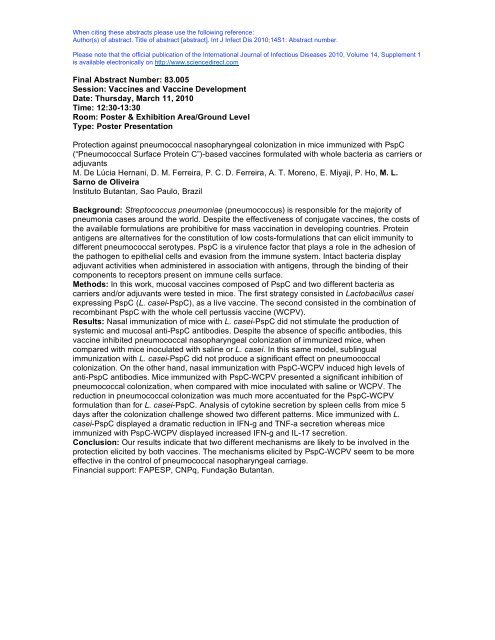14th ICID - Poster Abstracts - International Society for Infectious ...
14th ICID - Poster Abstracts - International Society for Infectious ...
14th ICID - Poster Abstracts - International Society for Infectious ...
Create successful ePaper yourself
Turn your PDF publications into a flip-book with our unique Google optimized e-Paper software.
When citing these abstracts please use the following reference:<br />
Author(s) of abstract. Title of abstract [abstract]. Int J Infect Dis 2010;14S1: Abstract number.<br />
Please note that the official publication of the <strong>International</strong> Journal of <strong>Infectious</strong> Diseases 2010, Volume 14, Supplement 1<br />
is available electronically on http://www.sciencedirect.com<br />
Final Abstract Number: 83.005<br />
Session: Vaccines and Vaccine Development<br />
Date: Thursday, March 11, 2010<br />
Time: 12:30-13:30<br />
Room: <strong>Poster</strong> & Exhibition Area/Ground Level<br />
Type: <strong>Poster</strong> Presentation<br />
Protection against pneumococcal nasopharyngeal colonization in mice immunized with PspC<br />
(“Pneumococcal Surface Protein C”)-based vaccines <strong>for</strong>mulated with whole bacteria as carriers or<br />
adjuvants<br />
M. De Lúcia Hernani, D. M. Ferreira, P. C. D. Ferreira, A. T. Moreno, E. Miyaji, P. Ho, M. L.<br />
Sarno de Oliveira<br />
Instituto Butantan, Sao Paulo, Brazil<br />
Background: Streptococcus pneumoniae (pneumococcus) is responsible <strong>for</strong> the majority of<br />
pneumonia cases around the world. Despite the effectiveness of conjugate vaccines, the costs of<br />
the available <strong>for</strong>mulations are prohibitive <strong>for</strong> mass vaccination in developing countries. Protein<br />
antigens are alternatives <strong>for</strong> the constitution of low costs-<strong>for</strong>mulations that can elicit immunity to<br />
different pneumococcal serotypes. PspC is a virulence factor that plays a role in the adhesion of<br />
the pathogen to epithelial cells and evasion from the immune system. Intact bacteria display<br />
adjuvant activities when administered in association with antigens, through the binding of their<br />
components to receptors present on immune cells surface.<br />
Methods: In this work, mucosal vaccines composed of PspC and two different bacteria as<br />
carriers and/or adjuvants were tested in mice. The first strategy consisted in Lactobacillus casei<br />
expressing PspC (L. casei-PspC), as a live vaccine. The second consisted in the combination of<br />
recombinant PspC with the whole cell pertussis vaccine (WCPV).<br />
Results: Nasal immunization of mice with L. casei-PspC did not stimulate the production of<br />
systemic and mucosal anti-PspC antibodies. Despite the absence of specific antibodies, this<br />
vaccine inhibited pneumococcal nasopharyngeal colonization of immunized mice, when<br />
compared with mice inoculated with saline or L. casei. In this same model, sublingual<br />
immunization with L. casei-PspC did not produce a significant effect on pneumococcal<br />
colonization. On the other hand, nasal immunization with PspC-WCPV induced high levels of<br />
anti-PspC antibodies. Mice immunized with PspC-WCPV presented a significant inhibition of<br />
pneumococcal colonization, when compared with mice inoculated with saline or WCPV. The<br />
reduction in pneumococcal colonization was much more accentuated <strong>for</strong> the PspC-WCPV<br />
<strong>for</strong>mulation than <strong>for</strong> L. casei-PspC. Analysis of cytokine secretion by spleen cells from mice 5<br />
days after the colonization challenge showed two different patterns. Mice immunized with L.<br />
casei-PspC displayed a dramatic reduction in IFN-g and TNF-a secretion whereas mice<br />
immunized with PspC-WCPV displayed increased IFN-g and IL-17 secretion.<br />
Conclusion: Our results indicate that two different mechanisms are likely to be involved in the<br />
protection elicited by both vaccines. The mechanisms elicited by PspC-WCPV seem to be more<br />
effective in the control of pneumococcal nasopharyngeal carriage.<br />
Financial support: FAPESP, CNPq, Fundação Butantan.
















